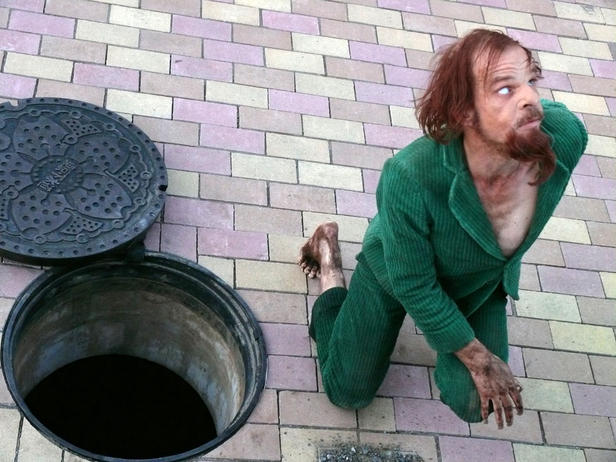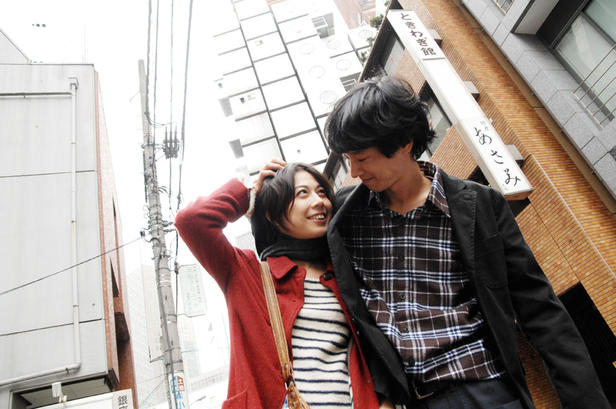Copyright ©2009 PopEntertainment.com. All rights reserved.
Posted:
March 15, 2009.
As
if it were a creative corollary to the act of cinematic deconstruction, this
strange tri-parted feature, Tokyo!,
was released on the same weekend as
Watchmen – a film based on a huge graphic novel that's all about
deconstruction. This strange absurdist-cartoon interpretation of the
ultimate urban megopolis, Tokyo!
takes on the town and the idea of a modern, functioning city through the
eyes of three foreigners: two Frenchmen, Michel Gondry (“Interior
Design”) and Leos Carax
(“Merde”)
and the South Korean born-and-bred Bong Joon-Ho (“Shaking
Tokyo”).
It was an odd yet funny move that this film's Japanese producers, Masa
Sawada and Michiko Yoshitake, chose three foreigners from two distinctly
different countries: the idiosyncratic filmmakers Gondry, who of course
established himself through such strange narratives as
Be Kind Rewind; Carax who was
acclaimed for The Lovers on the Bridge
and Pola X only to
disappear for a decade; and Bong, who made a though-provoking horror film,
The Host, before this.
Through this triptych, each director deals with alienation within this
near-futuristic city, but offers distinctly different takes and conclusions.
In Interior Design, a
couple moves to Tokyo to confront the big city but as they sink into the
mire, each one becomes alienated in very different ways. A shambling human
monster in the form of a homeless wreck goes on a rampage in
Merde; he is subsequently
captured and put on trial. In Shaking Tokyo an agoraphobic (known as a
hikikomori in Japan) rescues a
pizza delivery girl during an earthquake and falls in love with her.
As peculiar a film as this is, it was fortunate that at least the two French
directors came to New York to discuss their work with a few writers, in
whatever cryptic and perplexing Gallic inflected terms they could muster.
 Is
this film a deconstruction of Tokyo? What was your goal in analyzing Tokyo
through cinema?
Is
this film a deconstruction of Tokyo? What was your goal in analyzing Tokyo
through cinema?
Michel Gondry: I think the duration of each segment sort of pushed us
to create something surprising, because you just have 30 minutes, and it
leads you to [do] something abnormal. I don’t know how it is for everybody
else, because we didn’t speak to each other, and we didn’t know what
subjects [the other filmmakers] were treating, but I think this duration
pushes you to bring [in] more unexpected elements. There is a feeling of
[the] monster in Tokyo. Gabrielle [Bell, co-writer and author of the source
material, a story from her graphic novel collection], and I were reading
some [Haruki] Murakami and Edogawa Rampo, and I remember the Murakami story
was about a giant frog who has to fight a giant snake. It’s a very good one!
And there’s actually this [Edogawa Rampo] story of this guy in a chair.
Pretty creepy!
Leos, did you feel the same way about the effect the shorter duration had
on your approach to the segment you made?
Leos Carax: With a project called Tokyo!, or “Paris,” or “New
York,” it’s very superficial. You’re in the position of a foreigner, and
we’re three foreigners, it’s us vs. Tokyo, so it was a superficial position.
So I of course tried for [Merde, the sewer monster] to be the “ultimate
foreigner.” I imagined he would be like a child from some lost civilization,
with his own religion – a fundamentalist, terrorist child – and to use the
pop culture of the monster in the city.
Was Merde’s milky eye in homage to Henri-Georges Clouzot's 1955 film
Les Diaboliques?
Leos Carax: No. I don’t do homage [laughs].
After he rampages through the city and then is captured, Merde talks
about how he was born of the people in the trial sequence; he’s their son,
and they raped his mother. Was this a social comment on how the west is
breeding terrorists?
Leos Carax: It’s a bit ridiculous, the psychology inside these
monster films! It’s not very serious, and not some [huge] statement. I mean
monsters are always a product of the system, but it’s not meant to be [a
cultural criticism].
 When
you take us down into the monster’s cave, there are objects there that seem
to be a reckoning with or at least, an acknowledgement of the past – with
accoutrements reminiscent of Nanking. Was this intentional? Is this
monster, this "character from the Id" let loose on the street, a reckoning
of the past?
When
you take us down into the monster’s cave, there are objects there that seem
to be a reckoning with or at least, an acknowledgement of the past – with
accoutrements reminiscent of Nanking. Was this intentional? Is this
monster, this "character from the Id" let loose on the street, a reckoning
of the past?
Leos Carax: When I say I could’ve made the film in any other city,
it’s true, but since it was Tokyo, I used elements from the sewers to get at
their past. That’s why I used Nanking, because it’s their big trauma. But
it’s a very clichéd thing to have the monster use whatever the civilization
has produced against it, whether it be [something] nuclear with Godzilla,
or here, it’s grenades from Nanking that the monster’s going to use against
today’s Japanese. It’s a monster movie, and it’s about the ultimate
foreigner coming out of the sewers and killing everyone on the streets.
Michel, did you take some trip to Tokyo that left a lasting impression on
you? Is that what inspired you to make your segment?
Michel Gondry: Oh yeah! We all went to each other, “Let’s go make a
movie about Tokyo!” No, the producers just called us.
Did you coordinate with each other on the three themes of these films?
Michel Gondry: I tried to, but this guy [gesturing to Carax]
didn’t want to!
Did you know each other before?
Michel Gondry: Yeah, we met once before.
Leos Carax: There were three films, but none of us knew what the
others were doing.
Leos, you’ve had two long absences from filmmaking in your career, from
1991’s The
Lovers on the Bridge to 1999’s
Pola X,
and between that film to now with
Tokyo!
What were the reasons for these long gaps in your resume?
Leos Carax: [Shrugs] No particular reason… I just didn’t get
to make the films I wanted to. This was an opportunity to make something....
Michel Gondry: It was a great offer that I experienced with this
movie. The main constraint [in getting films made] is to get a famous actor
to finance the film – especially in America. We didn’t have to do that
[here] because it was a third of the film, and the producer was not there to
say, “No, you can’t do that!” Ryo Kase [who starred in
Letters from Iwo Jima] is
pretty famous, but Ayako is not. It was good that we didn’t know [who]
anyone [was], because we chose them for the right reasons.
 You
did cast Ayako Fujitani, Steven Seagal’s daughter, in your segment
Interior Design.
You
did cast Ayako Fujitani, Steven Seagal’s daughter, in your segment
Interior Design.
Michel Gondry: I love Steven Seagal so much! No… [laughs].
After the shooting, I did a documentary on Ayako and we met her father and
put them together, and it was pretty crazy. Actually, he’s a cop. In
Louisiana, he has a radio, and if he hears about a murder – a rape or a
murder – he goes and takes the bad guy out! Just imagine: you’re a bad guy,
and you get caught by the police, and it’s fucking Steven Seagal arresting
you with his gun! [Laughs] He’s like that, and he wanted his daughter
to be a cop too. He thought it would be safe for her, but she was like,
“Dad, how is it safe to be a cop?” He had a very weird logic… But anyway, we
picked her because she sort of reminded Gabrielle of the original character
she wrote the story about. We didn’t know she was half American at the time.
We believed she was Japanese and could speak really good English, and she
responded very well to the sensibility of the story – probably due to the
fact that she’s half American – but we didn’t know that at the time.
A lot of your films explore the psychological toll that relationships
have on people, whether it be The Science of Sleep, Eternal
Sunshine of the Spotless Mind, or this segment “Interior Design.” Why are
you so attracted to exploring this theme in your films?
Michel Gondry: Well, I spend a lot of time trying to figure out
what’s wrong with me in this matter, and when it comes to doing a movie I’m
naturally inclined to keep this reflection going. I would have a hard time
to do a movie about a restaurant. To be invited in a good or bad restaurant
doesn’t really speak to me… or, a movie on Wall Street – although that’s
come to be in my interest seeing the situation [now]. But, it seems to be
more naturally… how I use my brain, by deviance or obsession or whatever, so
it’s easier for me to think about that than other subjects.
Many of your films have that "theatre of the absurd" aspect to them, and
you have a knack for casting comedic actors in many of your films. What is
the role of comedy in your films?
Michel Gondry: Well, I think its measure is a little in-between. Like
if I go to a video store, I don’t know where I’m going to look for my
movies. Like Eternal Sunshine –
sometimes it’s in [the] comedy [section], sometimes it’s in drama, and
it’s always problematic. A lot of directors come from [music videos] like
me, with slick visuals and fashionable attitude which I don’t really like,
so I have more of this comedic element. As for the casting, I draw more on
how I think they’re going to express their comedy. But on the other hand, I
got an actor as [well known as] Jim Carrey [he starred in
Eternal Sunshine of The Spotless Mind]
who wanted to become dramatically believable, so you get an actor who’s
going to take a chance on you [in place of] an actor you [can] afford.
Everybody wants to be Tom Hanks, and Jim Carrey has this obsession – he made
this bitter comment how he’s always nominated for the Golden Globe but never
for the Oscar. He’s having a huge career, yet he still feels a lack of
recognition, so [he's one of] those actors are really drawn into taking
chances.
This is a country with a high suicide rate, yet there is this drive to be
capitalistic conformists. Did this play out in your film?
Michel Gondry: One thing that was a little problem to deal with is
the idea that the chair is not a traditional furniture in Japan. It’s more
recent, but once we visited Japan, we saw people do have dinner with chairs,
so it was ok. A lot of the time, there’s still this idea to sit around a
small table and sit on your knees, but the chair existed. The idea you’re
referring to, to suicide – I think there’s something about self-erasing in
Japan, like the idea of a woman wearing the bandage to make her feet
smaller, and I think that reflects that idea pretty well. The original story
written by Gabrielle was about a couple in New York, but there are elements
in Japanese culture which actually accentuates and gives meaning to this
transformation that were maybe not so obvious in New York.
What did you feel about the sense of alienation in Japanese society?
Michel Gondry: Honestly, when I go to a country like Japan, which
seems very foreign [to me], I try to look for the resemblances more than the
differences, and it takes a while to see that. It takes the same time as it
does to make friends. For instance, you don’t really choose your friends –
you see what’s inside them, and then you can identify the same motivations,
the same problems; there are similarities inside them to what is inside you,
so I look more for that. Though the original story was happening in New York
as I said, but with Tokyo [the feeling] was even stronger. I could talk
about what I find very specific in Tokyo… It’s a very fluid and quiet city
at the same time – very energetic yet quiet – because people are not so
expressive [as in the States]. When I went back to America after spending a
few months in Tokyo, I found people were walking like [they were galloping]
horses!
In your segment, the girl transforms back and forth from being a chair.
It seems obvious that you were influenced by the Surrealist movement...
Michel Gondry: This is how my influences work, if there is any: I
have a dream, and then I put it in a movie because I think that’s my dream,
and then I realize my dream was influenced by whoever, and [then] I feel I’m
stealing! But because it’s been digested by my dream, I feel legitimate in
using it. It’s not always like that… I remember having a conversation with
Charlie Kaufman [who wrote Eternal
Sunshine...] about breaking into an ex-girlfriend’s apartment.
Actually I did it in my life – it was pretty creepy! Then I put it in a
movie, so was I stealing the idea from Charlie? But I lived it! I lived it
maybe because Charlie and I talked about it. See, it’s hard for me, you
never know. I try to invite influences, but I prefer to watch movies and get
stimulated. It’s very dangerous to claim yourself to be a surrealist,
because there is something about the quality of dreams that you can’t
pinpoint. It vanishes. I think that a lot of directors, in my opinion, who
are visually surrealist, are anything but. All the visuals in advertising…
there are some directors, I won’t mention them now, but they take so much
from the surface of surrealism. I know the guy who did the costumes for
Ivan the Terrible, and it was just after World War II, and they had no
money. It was in black & white, and to do the earring of Ivan, they took
some chestnut shells, covered them in tin foil, and put them on the ear, and
it looked amazing! When I hear with Titanic that they went all the
way to China to get the plates… A lot of people working in advertising just
take the surface, and I don’t think it has anything to do with surrealism.
There are qualities in the surrealist films that are very handmade and put
together, because it leaves gaps for the brain to fill.
Leos, would you
consider yourself a surrealist?
Leos Carax: No. I don’t know much about surrealism…
Email
us Let us
know what you
think.
Features
Return to the features page.